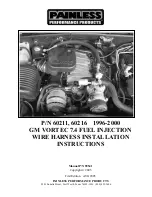
Starting the Engine
Before Starting
When starting in cold weather, keep all unnecessary electrical
circuits off (lights, defogger, etc.) for the best battery output.
Manual Transmission:
1. Apply the parking brake.
2. Push the clutch pedal all the way in (see NOTE below).
3. Shift the transmission to neutral.
NOTE: On cars equipped with manual transmissions, the engine
will not crank unless the clutch pedal is fully depressed.
Automatic Transmission:
1. Make sure the shift lever is in Park (P).
2. Apply the parking brake and foot brake.
Starting the Engine:
During the following starting procedures, do not crank the engine for
more than 15 seconds at a time. If the engine won't start, wait 10
seconds before going to the next step.
1. With your foot off the accelerator, start the engine by turning the
key to the I I I position.
2. If the engine won't start within 15 seconds or starts but fails to
continue to run, push the accelerator pedal halfway, and hold it
there while cranking the engine. If the engine starts, release the
accelerator gradually.
3. If it doesn't start within 15 seconds, push the accelerator pedal
down to the floor and hold it there while cranking. If the engine
starts, release the accelerator gradually. If it doesn't start, repeat
step 2.
Cold Weather at High Altitude Starting:
1. When starting in cold weather at high altitude (above 8,000 feet),
push the accelerator pedal about halfway and hold it there while
cranking the engine. If the engine starts, release the accelerator
gradually.
2. If it doesn't start within 15 seconds, push the accelerator pedal
down to the floor and hold it there while cranking. If the engine
starts, release the accelerator gradually. If it doesn't start, repeat
step 1.
NOTE: If the outside temperature is below freezing, or if your car has
not been driven for several days, warm up the engine for a few
minutes before driving.
















































